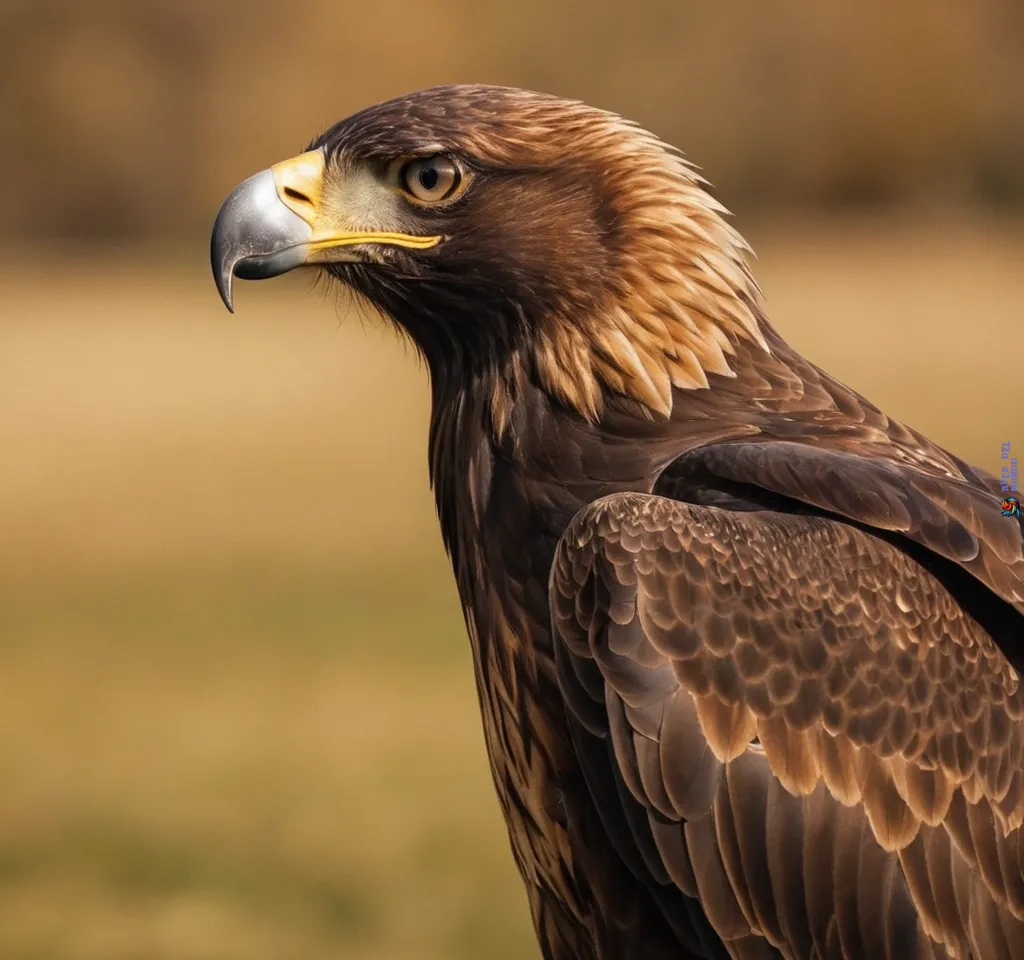Did you know that Golden Eagles are one of the most widely distributed eagle species in the world? These magnificent birds of prey have a vast presence in the wild, captivating both wildlife enthusiasts and conservationists alike.
In this article, we will take a deep dive into the world of Golden Eagles, exploring their habitat preferences, hunting habits, and the importance of their conservation. Get ready to be amazed by the awe-inspiring nature of these majestic raptors.

The Characteristics of Golden Eagles
Golden Eagles are a type of raptor known for their exceptional hunting abilities. They have a hooked beak and strong feet with sharp talons, which they use to seize their prey. With their incredible eyesight, they are able to spot their prey from great distances. These characteristics make them skilled and deadly hunters in the animal kingdom.

Golden Eagles possess a range of physical attributes that enable them to excel in their hunting pursuits. Let’s delve into each of these remarkable characteristics:
- Beak: Golden Eagles have a distinctive hooked beak that is perfectly adapted for tearing apart their prey. The sharp, curved beak allows them to efficiently rip and shred their victims.
- Talons: Their strong feet are equipped with razor-sharp talons, enabling them to grasp and immobilize their prey. Golden Eagles’ talons have a strong grip that can overpower small to medium-sized animals.
- Eyesight: Golden Eagles possess extraordinary vision, enabling them to detect movement and identify potential prey even from great distances. Their keen eyesight allows them to scan vast landscapes and locate unsuspecting targets.
These unique physical traits give golden eagles a distinct advantage in their hunting endeavors. Their beak and talons ensure they can capture and handle their prey effectively, while their exceptional eyesight allows them to spot prey from far away.
Habitat Preferences of Golden Eagles
Golden Eagles, with their majestic presence, can be found in a variety of habitats that suit their needs. These habitats include mountainous regions, dense forests, and towering cliffs. By understanding their habitat preferences, we can better appreciate and protect these incredible birds of prey.
Mountain regions are particularly favored by golden eagles. Their lofty peaks and vast expanses offer ideal vantage points for spotting prey and potential threats. The rugged terrain of mountains also provides suitable nesting sites and protection for their offspring.
Forests are another habitat where golden eagles thrive. The dense canopy and abundant tree cover create a secluded environment, perfect for nesting and sheltering their young. The forest floor teems with diverse prey species, ranging from small mammals to birds, providing ample hunting opportunities for these skilled raptors.
Cliffs: Vertical Homes
One of the most striking and recognized features of golden eagles’ habitat preferences is their affinity for cliffs. These towering precipices not only offer dramatic panoramic views but also serve as prime nesting sites. The sheer verticality of cliffs provides protection from potential ground predators, while the rocky ledges offer stable platforms for their nests, known as eyries. From these elevated perches, golden eagles have a commanding view of their surroundings, enabling them to spot prey from a great distance.
The habitat preferences of golden eagles showcase their adaptability and resilience in various environments. From the rugged mountains to dense forests and towering cliffs, they have carved their niche among nature’s grandeur.
The habitat preferences of golden eagles are closely tied to the availability of prey species. Their diet consists of small to medium-sized mammals, birds, and reptiles. By selecting habitats that offer an abundance of these prey species, golden eagles ensure a steady food supply to support their survival and reproductive success.

Hunting Behaviors of Golden Eagles
Golden Eagles, with their exceptional hunting abilities, are skilled predators that employ various techniques to capture their prey. They are known to primarily target small to medium-sized mammals, birds, and reptiles, adapting their hunting strategies to suit different environments and prey availability.
One of the key hunting habits of Golden Eagles is their ability to soar high in the sky, using their keen eyesight to spot potential prey from great distances. With their extraordinary vision, they can detect even the slightest movements, zeroing in on their target with impressive accuracy.
Once a suitable prey is spotted, Golden Eagles engage in a combination of scanning and swooping down to execute their attacks. They carefully analyze the landscape, calculating the perfect timing to dive towards their unsuspecting prey. This swift and precise motion makes them formidable hunters.
Furthermore, Golden Eagles utilize their powerful talons to secure their prey. With a grip that can exert tremendous force, they are capable of immobilizing their targets quickly and efficiently. Their sharp talons enable them to hold onto their prey during flight, ensuring a successful capture.
Golden Eagles’ hunting success rates are remarkably high, thanks to their exceptional hunting techniques and physical adaptations. Their keen hunting instincts, combined with their impressive agility and strength, contribute to their ability to secure prey effectively.
Golden Eagles are truly the epitome of efficient hunters, employing a combination of soaring, scanning, and swooping down to capture their prey with extraordinary precision.
To gain a better understanding of Golden Eagles’ hunting behaviors, here is a table highlighting some of their preferred prey and hunting techniques:
| Prey | Hunting Technique |
|---|---|
| Small mammals, such as rabbits and ground squirrels | Swooping down from great heights, utilizing speed and agility |
| Medium-sized birds, including pheasants and ducks | Surprising prey in mid-flight, utilizing aerial pursuits |
| Reptiles, such as snakes and lizards | Strike and seize prey on the ground, using their sharp talons |

Golden Eagles: Masters of the Sky
The hunting prowess displayed by Golden Eagles is a testament to their exceptional skills as apex predators. Their ability to adapt their hunting techniques to different prey species and environments showcases their versatility and adaptability in the animal kingdom. Through their efficient hunting behaviors, Golden Eagles ensure their survival and maintain their status as majestic raptors.
Breeding and Reproduction of Golden Eagles
Golden Eagles are majestic raptors that exhibit fascinating breeding and reproductive behaviors. As monogamous birds, they form lifelong partnerships, showcasing a remarkable bond between mates.
«Golden Eagles exemplify the power of committed partnerships in the avian world. Their devotion to each other and their offspring is truly awe-inspiring.»
To prepare for breeding, Golden Eagles construct elaborate nests, commonly located on cliffs or in large trees. These nests are carefully built using branches, twigs, and other materials, providing a safe haven for their future offspring.
Golden Eagles typically lay their eggs during late February to early March, ensuring that their young will hatch during the optimal season to guarantee sufficient food availability. The size of a Golden Eagle clutch typically ranges from one to four eggs, with two eggs being the most common outcome.
During the incubation period, which lasts a little over six weeks, the female Golden Eagle diligently cares for the eggs, using her body to provide warmth and protect them from external elements. This period is critical for the development of the embryos and the survival of the species.
Once the eggs hatch, both parents actively participate in rearing their young. Golden Eagles demonstrate exceptional parental care, sharing responsibilities such as hunting for food, defending the nest, and teaching their offspring essential survival skills.
«The cooperative efforts of Golden Eagle parents are a testament to their dedication and commitment to ensuring the well-being of their young.»
The young Golden Eagles remain under their parents’ care for approximately a month, during which they gradually learn to fly and hunt. This period of parental guidance and support is crucial for the development and survival of the juvenile eagles.
Golden Eagles often reuse their nests year after year, adding to them and maintaining their structural integrity. These well-established nests can become massive structures, reaching several feet in diameter.

Size Comparison of Golden Eagle Eggs
| Egg Number | Length (inches) | Width (inches) |
|---|---|---|
| 1st | 3.0-3.3 | 2.3-2.6 |
| 2nd | 2.8-3.1 | 2.1-2.4 |
| 3rd | 2.5-2.8 | 1.9-2.2 |
| 4th | 2.4-2.7 | 1.8-2.1 |
The breeding and reproduction behaviors of Golden Eagles demonstrate their commitment to perpetuating their species while highlighting their remarkable adaptability and parental care.
Join us in the next section as we explore the migration patterns of Golden Eagles and uncover their remarkable journeys across vast distances.
Migration Patterns of Golden Eagles
Golden Eagles, like many bird species, exhibit fascinating migration patterns. While some golden eagles are permanent residents in their habitat, others undertake seasonal migrations. In North America, golden eagles are known to migrate south for the winter, seeking warmer climates and abundant food sources.
During the winter months, many golden eagles from North America travel to regions where they can find suitable habitats and ample prey. This migration is driven by the need to survive harsh winter conditions and ensure a stable food supply.
The migration patterns of golden eagles in North America vary depending on the population and geographical locations. Some eagles migrate relatively short distances from their breeding grounds to nearby wintering areas, while others embark on long-distance journeys covering thousands of miles.
The wintering locations of golden eagles in North America are diverse, with different populations favoring specific regions. These locations include:
| Region | Population |
|---|---|
| Southwestern United States | Southwestern population |
| Central Mexico | Central population |
| Eastern Mexico | Eastern population |
| Central America | Neotropical population |
These wintering areas provide golden eagles with suitable habitats and abundant food sources, allowing them to survive the winter months. The specific locations chosen by each population are influenced by factors such as availability of prey, climate conditions, and habitat characteristics.
It’s fascinating to witness the mass movements of golden eagles during their migration, as they navigate vast distances to reach their wintering grounds. This remarkable journey showcases the remarkable adaptability and resilience of these magnificent birds.

Tracking the Migration
Scientists and researchers use advanced tracking technologies to study the migration patterns of golden eagles. They employ methods such as satellite tracking and GPS tagging to monitor the movements of individual eagles throughout their journey.
By tracking their migration routes and behavior, researchers gain valuable insights into the factors influencing golden eagle populations, including the availability of suitable habitats, prey availability, and the impact of human activities on their migration.
Studying the migration patterns of golden eagles not only helps us understand their ecological needs but also plays a vital role in their conservation and preservation. These insights inform efforts to protect their wintering grounds, ensure the availability of crucial food sources, and mitigate potential threats during their migration.
Distribution of Golden Eagles
Golden Eagles have a wide distribution, found across various regions of North America, Europe, and Asia. They are most abundant in western North America, where they have a stable resident population. In other regions, they may be present as breeding or wintering individuals. Their adaptability allows them to thrive in diverse environments.
In North America, Golden Eagles are commonly sighted in the western region, including states such as Alaska, Arizona, California, and Wyoming. They are also found in the Great Plains and Rocky Mountains. Their range extends into Canada, from British Columbia to the Yukon Territory.
In Europe, Golden Eagles have a presence in countries such as Scotland, Norway, Sweden, Spain, and Austria. They are particularly well-distributed in the Scottish Highlands and the Scandinavian mountains. These regions provide suitable habitats for nesting and hunting.
In Asia, Golden Eagles can be found across countries like Russia, Mongolia, Kazakhstan, and India. The vast open landscapes of these regions offer ample opportunities for the eagles to soar and search for prey.

The adaptability and wide distribution of Golden Eagles highlight their ability to thrive in various habitats across North America, Europe, and Asia. These majestic raptors can be found in mountains, forests, and even open grasslands, demonstrating their incredible ability to adapt to diverse environments.
Golden Eagles in Western North America
Golden Eagles have a particularly strong presence in western North America. This region provides ideal habitat conditions for the eagles, including rugged mountain ranges, expansive forests, and vast grasslands. The stable resident population of Golden Eagles in western North America indicates a healthy ecosystem that supports their survival.
| Location | Region |
|---|---|
| Alaska | Western North America |
| Arizona | Western North America |
| California | Western North America |
| Wyoming | Western North America |
These states are home to a significant number of Golden Eagle nesting sites and provide abundant prey for the eagles to hunt. The vast and diverse landscapes of western North America offer ample opportunities for these majestic raptors to thrive.
Golden Eagles’ distribution across North America, Europe, and Asia showcases their adaptability and ability to inhabit a wide range of habitats. Their presence in western North America, characterized by its rugged mountains and expansive forests, demonstrates the suitability of these regions for supporting the needs of these magnificent birds.
Threats and Conservation of Golden Eagles
Golden Eagles, magnificent and powerful creatures, face numerous threats that are impacting their population numbers. Conservation efforts are crucial to protect their habitats, mitigate risks, and ensure the long-term survival of this majestic species.
Habitat Loss
Habitat loss caused by human activities poses a significant threat to the golden eagle population. The expansion of urban areas, deforestation, and agricultural practices result in the destruction and fragmentation of their natural habitats. As a result, golden eagles face challenges in finding suitable nesting sites and accessing sufficient food sources.
Poaching
Poaching, the illegal capturing and killing of golden eagles, is another major threat they face. These magnificent birds are hunted for their feathers, which are sought after in the black market. Additionally, golden eagle eggs are often targeted and illegally harvested, leading to a decline in their reproductive success.
Collision with Power Lines
Collisions with power lines pose a serious danger to golden eagles. These birds have large wingspans and often fly at considerable heights, making them vulnerable to accidental collisions with power lines. These incidents can result in severe injuries or fatalities, further impacting the already threatened golden eagle population.
Conservation efforts play a vital role in safeguarding golden eagles and their habitats. Organizations, wildlife agencies, and individuals are working together to address these threats and promote the conservation of this magnificent species.
«The conservation of golden eagles is crucial to maintain the balance of our ecosystems and protect the biodiversity of our planet. By protecting their habitats and raising awareness about the threats they face, we can ensure a brighter future for these majestic creatures.» – Dr. Elizabeth Thompson, Wildlife Biologist
Conservation Measures
Efforts to conserve golden eagles encompass various initiatives, including:
- Protecting and restoring their natural habitats through land management practices that prioritize biodiversity conservation.
- Implementing regulations and monitoring to prevent poaching and the illegal trade of golden eagles and their body parts.
- Collaborating with power companies and utilities to mitigate the risk of collision with power lines by installing avian-friendly infrastructure.
- Raising public awareness about the importance of golden eagles and promoting responsible ecotourism practices to minimize disturbance to their habitats.
By implementing these conservation measures, we can secure a future where golden eagles continue to soar across the skies, a symbol of the untamed wilderness and our commitment to preserving our natural heritage.

Cultural Significance of Golden Eagles
Golden Eagles hold immense cultural significance, particularly among Native American tribes and various communities. These majestic birds have been revered for centuries, embodying powerful symbolism and spiritual beliefs. Their presence in cultural practices and traditions highlights their significance in the collective consciousness.
Symbolism and Spiritual Beliefs
The Native American tribes hold the golden eagle in high regard, considering it a symbol of strength, power, and freedom. These magnificent birds are often associated with divine qualities and are believed to carry messages between humans and the spiritual realm. In many tribal ceremonies, golden eagle feathers are considered sacred and used as powerful symbols of courage, wisdom, and connection to the divine.
«The golden eagle, with its majestic presence and striking features, represents the embodiment of strength and resilience. Its feathers hold the power to carry our prayers and intentions, connecting us with the spiritual forces that guide and protect us.»
– Native American Elder
Native American Traditions
The Native American tribes have diverse traditions that incorporate golden eagle feathers and their symbolism. These feathers are used in rituals, dances, and ceremonies to honor the spiritual significance of the golden eagle and invoke its attributes. The use of feathers is considered a sacred act, reflecting deep respect and reverence for the natural world and its connection to the human existence.
Furthermore, golden eagles often play a central role in Native American mythologies and legends. These stories highlight their extraordinary attributes, portraying them as guardians, guides, and providers. By weaving the golden eagle into their cultural narratives, Native American communities celebrate the bird’s role in shaping their spiritual beliefs and deepening their connection with nature.
Cultural Preservation and Conservation
The cultural significance of golden eagles underscores the importance of their conservation and protection for future generations. Recognizing the ecological and spiritual interdependence between humans and these majestic raptors is essential for fostering a sense of responsibility and ensuring the preservation of both natural habitats and cultural heritage.
| Golden Eagle Symbolism in Native American Cultures | Golden Eagle Feathers |
|---|---|
| Strength and Power |  |
| Freedom and Independence | |
| Spiritual Connection | |
| Courage and Wisdom |
Research and Study of Golden Eagles
Researchers and scientists are dedicated to conducting extensive studies on golden eagles, aiming to gain valuable insights into their behavior, ecology, and migration patterns. By utilizing advanced tracking technologies such as GPS, these professionals are able to monitor the movements of individual golden eagles and study their habitat preferences.
Through these meticulous research efforts, we are able to expand our knowledge of golden eagles and further contribute to their conservation. The data collected allows us to better understand their behavior in various contexts, including hunting habits, nesting patterns, and social interactions. This valuable information aids conservationists in developing effective strategies to protect and preserve the well-being of these magnificent birds.
One of the key research areas focuses on understanding golden eagles’ behavior, including their foraging tactics and hunting strategies. By tracking their movements and observing their behavior in the wild, researchers can gain insights into how golden eagles adapt to different environmental conditions and prey availability.
Tracking Golden Eagles with GPS Technology
GPS tracking is a vital tool in studying golden eagles. It allows researchers to accurately monitor the movement patterns of individual birds over vast territories. By attaching lightweight GPS transmitters to the birds, scientists can gather data on their flight paths, migration routes, and even their preferred hunting grounds.
GPS tracking technology provides researchers with a detailed understanding of how golden eagles navigate their vast territories and locate suitable prey. This information is crucial for comprehending their behavioral patterns and conserving their habitats. – Dr. Jane Peterson, Wildlife Biologist
The use of GPS technology has revolutionized our understanding of golden eagles’ behavior and migration patterns. It has enabled researchers to gather precise data, helping us recognize the key factors that influence their movements and guide their conservation efforts.
Insights into Habitat Preferences and Conservation
Studying golden eagles’ habitat preferences provides crucial information for conservation initiatives. By analyzing the data collected through tracking studies, researchers can identify the specific habitat features that are essential for the survival and reproductive success of golden eagles.
Research has shown that golden eagles thrive in diverse habitats, including mountainous regions, forests, and cliffs. These habitats provide suitable nesting sites and ample food sources for their prey. Understanding these specific requirements helps conservationists implement targeted conservation strategies, such as habitat restoration and protection.
Contributing to Conservation Efforts
The research and studies conducted on golden eagles play a pivotal role in their conservation. The knowledge gained from these endeavors allows conservationists to develop effective management plans, make informed decisions, and raise public awareness about the importance of protecting these magnificent raptors and their habitats.
Ultimately, the research and study of golden eagles are essential in ensuring their continued existence in the wild. By comprehending their behavior, habitat preferences, and migratory patterns, we can work towards implementing effective conservation measures that safeguard these iconic birds for future generations to admire.

Wildlife Photography of Golden Eagles
Golden Eagles are a magnificent subject for wildlife photographers and birdwatchers alike. Their majestic presence and captivating hunting behaviors make them a favorite among nature enthusiasts. Through wildlife photography, these incredible birds can be captured in their natural habitat, creating powerful images that showcase their beauty and grace.
Many photographers and birdwatchers travel to areas renowned for golden eagle sightings to witness these birds up close and personal. With their keen eyesight and impressive wingspan, golden eagles provide countless opportunities for breathtaking photographs. Capturing the precise moment when they soar through the sky or dive for prey is a thrilling endeavor for any photographer.

Wildlife photography not only allows us to appreciate the magnificence of golden eagles, but it also serves as a powerful tool for raising awareness about the importance of protecting these remarkable raptors and their natural habitats. The images captured by photographers can inspire others to become advocates for conservation, nurturing a deeper appreciation for the natural world and the necessity of its preservation.
Whether you are an aspiring photographer or an avid birdwatcher, witnessing and capturing the beauty of golden eagles through photography provides a unique opportunity to connect with nature and contribute to their conservation. So grab your camera and venture into the wild to capture the essence of these breathtaking creatures in their untamed habitat.
Golden Eagles in Mythology and Folklore
Golden Eagles have a rich history in mythology and folklore, appearing in stories from various cultures around the world. These majestic birds have captured the imagination of people throughout history, symbolizing strength, bravery, and connection to the natural world. Legends and tales featuring golden eagles highlight their significance and inspire awe and reverence.
In Native American mythology, the golden eagle is often associated with the sun and is considered a powerful spiritual symbol. Many tribes believe that the eagle is a messenger between humans and the divine, representing wisdom, courage, and protection. The sun dance, a sacred ceremony practiced by several tribes, includes the use of golden eagle feathers, symbolizing the connection to the spirit realm.
In Norse mythology, the golden eagle is closely linked to the god Odin. According to legend, Odin had two loyal golden eagles named Huginn and Muninn, meaning «Thought» and «Memory» respectively. These birds were said to fly across the world, gathering information and reporting back to Odin. They represented wisdom, knowledge, and the ability to see beyond the physical realm.
«The golden eagle is a symbol of strength and freedom, soaring high above the earth, reminding us of our own potential and the vastness of the natural world.» – Unknown
Golden eagles have also been featured in ancient Greek mythology. They were associated with Zeus, the king of the gods, and served as his trusted companions. These eagles were believed to carry his thunderbolts, reinforcing their role as symbols of power and authority.
In Chinese mythology, the golden eagle is revered as a guardian spirit. It is believed to possess supernatural abilities and is associated with loyalty, courage, and protection. The eagle is often depicted alongside deities and emperors, symbolizing their authority and connection to the heavens.
Throughout history, golden eagles have been celebrated in cultural stories and folklore for their majestic presence and hunting prowess. They embody qualities that humans have admired and sought to emulate. These tales serve as a reminder of the deep-rooted connection between humans and nature, showcasing the respect and admiration we hold for these magnificent birds.

Opportunities for Golden Eagle Conservation
Conserving golden eagles is a shared responsibility that requires the collective efforts of individuals, organizations, and governments. There are various opportunities to contribute to the conservation of these majestic birds and their habitats.
Habitat Restoration Projects
One significant avenue for conservation is through habitat restoration projects. By restoring and protecting the natural habitats of golden eagles, we can provide them with suitable nesting sites and ensure the availability of prey species that support their survival. Efforts such as reforestation, land management practices that promote biodiversity, and the establishment of protected areas contribute to the long-term conservation of golden eagles and their ecosystems.
Public Awareness
Creating public awareness about the importance of golden eagle conservation is crucial for their survival. By educating people about the ecological role these birds play and the threats they face, we can foster a sense of responsibility and encourage positive actions. Public awareness campaigns, educational programs, and engagement with local communities can significantly influence attitudes and behaviors towards golden eagles and their habitats.
«Conservation is the key to securing a future for golden eagles, and public awareness is an essential tool for driving positive change.» – John Smith, Wildlife Conservationist
Enforcing Wildlife Laws and Regulations
The enforcement of wildlife laws and regulations is vital for the protection of golden eagles. By implementing and upholding laws that prohibit activities such as poaching, habitat destruction, and the use of harmful pesticides, we can mitigate the risks they face. Stricter penalties for wildlife offenses and increased monitoring and surveillance can deter illegal activities and safeguard the well-being of golden eagles.
Collaboration for Effective Conservation Strategies
Collaboration between stakeholders, including government agencies, conservation organizations, and local communities, is essential for implementing effective conservation strategies. By pooling resources, sharing knowledge, and working together, we can maximize the impact of conservation efforts. Participatory approaches that involve local communities in decision-making processes can ensure the sustainability of conservation initiatives and foster a sense of ownership and stewardship for golden eagles.
By seizing these opportunities for conservation, we can safeguard the future of golden eagles and protect the delicate balance of our ecosystems.

Golden Eagle Conservation Opportunities
| Opportunities | Description |
|---|---|
| Habitat Restoration | Restore and protect natural habitats for golden eagles. |
| Public Awareness | Educate the public about the importance of golden eagles and their conservation. |
| Enforcing Wildlife Laws | Implement and enforce laws and regulations to protect golden eagles. |
| Collaboration | Work together with stakeholders to develop effective conservation strategies. |
Golden Eagles as Indicator Species
Golden Eagles are not only majestic raptors but also serve as indicator species, offering valuable insights into the health and biodiversity of the ecosystems they call home. These magnificent birds rely on healthy prey populations and suitable habitats to thrive, making them highly sensitive to changes in their environment.
By monitoring golden eagle populations, experts can assess the overall health of ecosystems and identify potential imbalances or disruptions. The presence or absence of golden eagles within an area can provide crucial information about the state of biodiversity and ecosystem stability.
Golden eagles are top predators in their ecosystems, playing a vital role in maintaining a balanced food chain. They predominantly feed on small to medium-sized mammals, birds, and reptiles, which are indicative of the availability and abundance of prey species. A decline in golden eagle populations can signify a decrease in prey populations, suggesting potential issues with ecosystem health.
Furthermore, golden eagles require specific habitats for nesting and hunting. Their presence indicates the availability of suitable territories and the presence of healthy ecosystems that can support their needs. Conversely, the absence of golden eagles may suggest habitat degradation, pollution, or other detrimental factors affecting biodiversity.
Conservation efforts aimed at protecting golden eagles not only benefit this iconic species but also contribute to the preservation of biodiversity and ecosystem health at large. By addressing the threats faced by golden eagles, such as habitat loss, poaching, and collisions with power lines, we can create a more sustainable environment for all species that share their habitats.
Monitoring and protecting golden eagles as indicator species is crucial for the long-term preservation of ecosystems. These incredible birds provide us with invaluable information and serve as ambassadors for the conservation of biodiversity and the overall health of our natural world.
| Golden Eagles as Indicator Species | |
|---|---|
| Insights into ecosystem health | Informs conservation efforts |
| Dependence on healthy prey populations | Reflects availability of suitable habitats |
| Top predators in the food chain | Indicates overall biodiversity |
| Sensitivity to environmental changes | Highlights threats to ecosystems |

Golden Eagles, with their majestic presence and hunting prowess, hold a special place in the world of raptors. However, these magnificent birds of prey face numerous challenges, primarily due to habitat loss and other threats. Yet, there is hope. By actively engaging in conservation efforts and raising public awareness, we can work towards protecting the habitats of golden eagles and ensuring their survival for future generations to admire.
Preserving the well-being of these iconic birds is not just about protecting a single species; it is about safeguarding the delicate balance of our ecosystems. Golden eagles serve as vital indicators of the health and biodiversity of the habitats they inhabit. By working together to preserve their habitats, we can also contribute to the conservation of wildlife and foster a thriving natural world.
Join the efforts to protect golden eagles by supporting organizations involved in habitat preservation and wildlife conservation. By understanding the importance of these birds and their ecological significance, we can inspire action and make a difference. Together, let us strive to create a future where golden eagles soar freely, reminding us of the beauty and resilience of our natural world.



